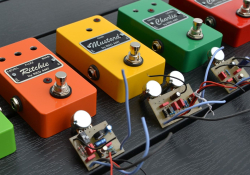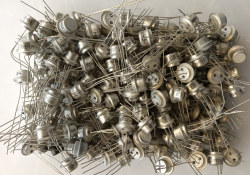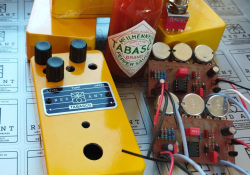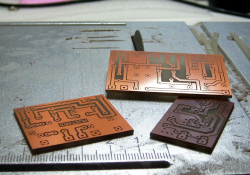
Dreamstruments #26: Red Ant Stompboxes
This interview with Radim Syvala, the man behind the Red Ant Stompboxes brand, is a thought-provoking recap of all that vintage boutique guitar stompboxes making involves. Determined and inspiring, he's following his dream, despite, literally deadly obstacles!
Radim started in his youth by amateurishly changing various DIY busters into soap boxes. Then for many years, he devoted himself only to acoustic guitar and only at his mature age he returned to his favourite blues and electrified old music. For that, he needed some guitar effects, and he commented with a smile that his innate stinginess made him reluctant to pay "exorbitant" prices for them. After all, the parts cost a few crowns, so he had to do it all for "a few bucks".
Reality, of course, gradually showed him that this complex discipline, involving an excessively varied range of activities for one person, is not so simple. In fact, it is a multidisciplinary activity which, in addition to the expected soldering and mechanical activities, also involves, for example, graphic work or logistics and supply. And talking about the design, it's certainly not going to cost a few hundred. Fortunately, Radim sensed right from the beginning that there would soon be a big shortage of quality parts, so he gathered a good supply of them from various second hands, eBay or army sales – and he certainly didn't make a mistake. Nowadays, prices can be as much as thirty times higher, and the quality required for vintage effects is becoming practically unaffordable. This type of components has ceased to be produced.
With emotions, Radim recalled the late David Stypka several times, who helped him in the beginning not only with support and testing of boxes but also with presentations, graphics or web programming. As he says, Red Ant would not exist in its present form without David and his unexpected death threw the spanner in Radim's works.
But the journey of the hard-working Red Ant had already started, so Radim focused on his favourite vintage sound and began to fine-tune his dream ideas based on interesting schemes and effects, patiently building his Red Ant portfolio. It's worth adding that all the world's famous companies take similar inspiration for their products, only on a much larger scale.
I asked Radim my obligatory question, which three of his "babies" would he single out or which would he take to a deserted island.
Red Ant Curare
Radim thought about this choice of Sophie's for a moment, and then reached for the red box with the poisonous name Curare.
Through David Stypka, Red Ant also reached the well-known producer Martin Ledvina (Jelen, Debbi, Robert Křesťan and many others), and word started to spread among musicians that Red Ant could deliver a quality vintage sound.
Red Ant Charlie
We even agreed on the second candidate, because Radim, like me, is a fan of the obscure old Harmonic Percolator fuzz. He explained how he looked at the scheme and didn't understand how it could work at all. So of course he decided to try it out.
I and Radim met earlier when voting on his new graphic design Red Ant, which I clearly supported and commented on.
Warning: music equipment maker friends, never – and I mean never! – never use the Brush Script font on your products, and certainly not diagonally! Yes, I know Fender uses it, and that's probably why it's spread like a highly infectious plague in this segment (and even some people like it). Typically, however, especially in combination with other fonts, it is unfortunately the equivalent of a graphic crime against humanity, in the style of the inappropriate overuse of the memorable Comic Sans font, or perhaps of shorts on stage or socks worn in sandals. Don't show the world in all your nakedness that you have no graphic sense, taste, creativity or inventiveness.
That's why I was delighted when the professional graphic designer Ondra Blažek offered his services to Radim and designed today's interesting and characteristic Red Ant face (which, by the way, won overwhelmingly in the poll among respondents).
Red Ant Lollipop
Of course, the fairground pink stompbox had to be named "lollipop" and on the floor plan of a rare dirty Univox Uni-drive booster (used by Jimmy Page / Led Zeppelin for example) Radim built a toy for himself, a pure handmade in Red Ant style including custom printed circuits. As he says, old boxes deserve good old handwork.
When he looked at the scheme, he knew right away this time that it would play great. He modified the oddly designed controls to today's standard and tweaked the sound of his pink dream. But, as gear guru Reinhold Bogner mentions, it's often the case that the thing you put the most energy and invention into unfortunately doesn't impress the public very much. By contrast, things made inadvertently become sales hits.
And a similar story happened here. The pink Lollipop didn't quite make it in the world, but the orange Ritchie, aka the most classic Fuzz Face, did. Radim didn't even want to make it, because a thousand people had already made it before him, but he let himself be convinced, tried to change the original base a lot according to his ideas and chose the best solid states. Ritchie is a great success among his customers and is currently one of his best-selling effects.
During the discussion, he also sighed that he was in a precarious situation, because when tuning the latest piece with Maťo Mišík they chose the name Foxtrot. Cruel fate crossed his path for the second time, because unfortunately the graphic Ondra Blažek also left us quite unexpectedly. And Radim can't find the font he used for his typical labels. He avoided it a few times by using letters from previous stompboxes, but he just doesn't have X. Life has written another beautifully unexpected story here. Since this was not a completely new assignment for me, I used a special font finder and finally managed to find the right one. With exaggeration, I saved the future of Red Ant...
It's proof that this series has a deeper meaning and is worth pursuing your dreams despite the odds. So you can look forward to the Red Ant Foxtrot soon, or the first Red Ant fully analogue modulation controlled digitally for more convenient control and setup. So if you have vintage dreams, Red Ant can help you make them come true.
If you have found an error or typo in the article, please let us know by e-mail info@insounder.org.











